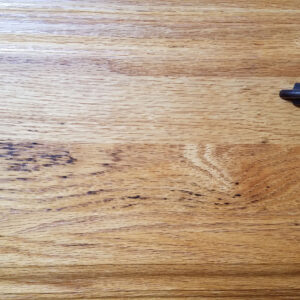Black stains re-appear after refinishing oak cabinets
I refinished a number of solid oak kitchen cabinets a year ago, first stripping off all the old finish with CitriStrip, washing with stripper wash, sanding to remove any remaining finish. Then I applied an oxalic acid wash to remove the black stains – which worked really well. Next I did the final sanding with 220 grit. Then I applied two coats of clear gloss polyurethane using a brush, finally spraying on two coats of satin polyurethane. This looked great! However, a year later again many areas are again showing black spots (not necessarily the same areas)? See photo for illustration. There is no visible damage to the finish. Why is this happening and how can it be prevented next time I refinish any cabinets?
I appreciate any insights and advice.
Thanks, Adriaan
















Replies
I just guessing. The area shown in your photo is a place where the open pores of the wood grain come to the surface. I wonder if these areas did not get completely sealed and water gets in when you wipe them down. Then, if your water has a high iron content, it might be causing more staining as the iron reacts with the tannin in the wood. Try applying some more oxalic acid and see if the spots disappear again. If so, that pretty much confirms it.
Or, maybe it is some mold/mildew in pores not completely filled. Try something that kills mold/mildew.
If either of these work, you will need to go back and apply more coats of poly and make sure those pores are sealed.
I think the wood looks great as is.
As a professional polisher i have had this happen to me more times than i wish to remember water based finishes are the worst culprit it rarely happens using solvent based finishes neutralising the oxcilic acid is a big help with sodium bicarb but it can still happen. With oak a good plan is first cellulose sanding sealer or better still a few rubbers of clear french polish will usually seal most contaminations.
Thanks everyone for the suggestions. FYI, I have been using oil-based poly urethane, no stain. I did neutralize after the oxalic acid, after doing this I rinsed the panel with plenty of water. Then I let it dry, sanded 220 grit etc.
In his book Understanding Wood Finishing, Bob Flexner states that "...you should not use a separate sanding sealer or wax-containing shellac under polyurethane." User-7830262, have you had issues with the poly urethane bonding to these since you suggest this or did you use a different finish?
At some point in the past I tried paste fillers on oak but they always gave it a yellow color I did not like.
Thanks, Adriaan
Sealcoat is a dewaxed shellac that is great underneath any finish you have doubts about.
This forum post is now archived. Commenting has been disabled